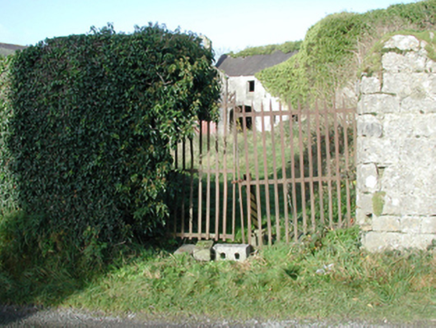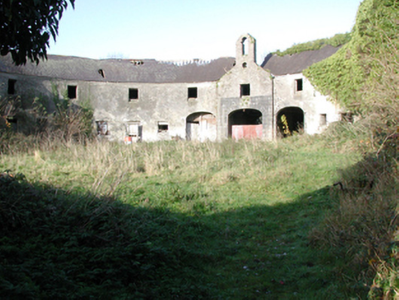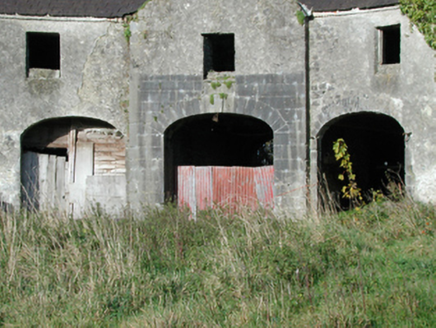Survey Data
Reg No
12401306
Rating
Regional
Categories of Special Interest
Architectural, Historical, Social
Original Use
Outbuilding
Historical Use
RIC barracks
Date
1800 - 1810
Coordinates
235797, 163585
Date Recorded
09/11/2004
Date Updated
--/--/--
Description
Detached nine-bay two-storey stable block, dated 1805, on a crescent-shaped plan centred on single-bay two-storey gabled breakfront. In alternative use, 1900. Now disused. Hipped slate roof on a crescent-shaped plan on collared timber construction centred on remains of pitched (gabled) slate roof (breakfront), clay or terracotta ridge tiles, rendered coping to gable with rendered gabled bellcote to apex, and no rainwater goods surviving on rendered red brick header bond eaves. Part creeper- or ivy-covered lime rendered or roughcast coursed rubble limestone walls with concealed cut- or hammered limestone flush quoins to corners; limestone ashlar surface finish (breakfront). Elliptical-headed central carriageway with limestone ashlar voussoirs centred on cut-limestone keystone with no fittings surviving. Elliptical-headed flanking carriageways with lime rendered or roughcast limestone ashlar voussoirs. Square-headed door openings with overgrown thresholds, and concealed dressings with no fittings surviving. Square-headed flanking window openings, concealed dressings with no fittings surviving. Square-headed window openings (first floor), concealed dressings with no fittings surviving. Set in unkempt grounds with part creeper- or ivy-covered piers to perimeter having overgrown capping supporting wrought iron-detailed flat iron double gates.
Appraisal
A stable block representing an important component of the early nineteenth-century built heritage of County Kilkenny with the architectural value of the composition, one most likely erected to serve the opposing Clomantagh Mills (see 12401307), confirmed by such attributes as the curvilinear footprint centred on a bellcote-topped breakfront; and the diminishing in scale of the openings on each floor producing a graduated visual impression. A prolonged period of neglect notwithstanding, the elementary form and massing survive intact together with quantities of the original fabric, thus upholding the character or integrity of a stable block making a pleasing, if increasingly forlorn visual statement in a rural street scene. NOTE: The stable block remains of additional interest for the period of reinvention as a constabulary barrack headed by Sergeant Richard Rose (----) and Sergeant John A. Jones (----) respectively (NA 1901; NA 1911).





